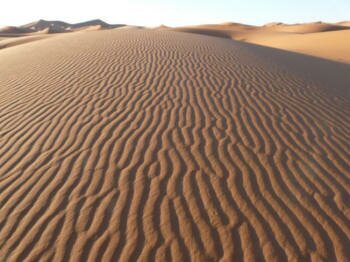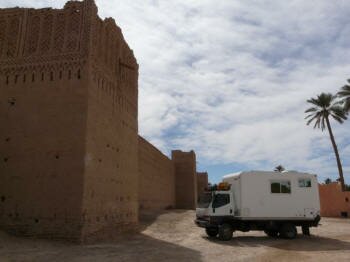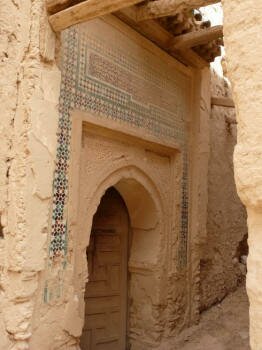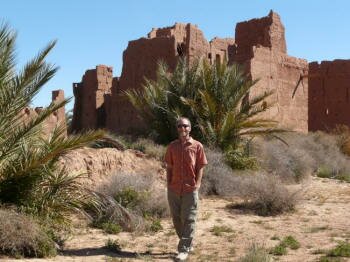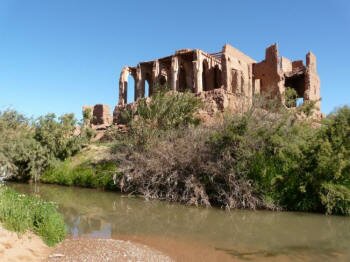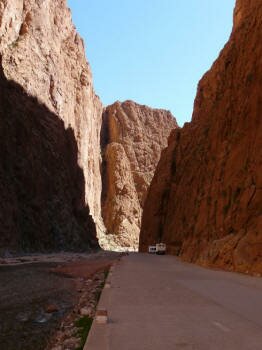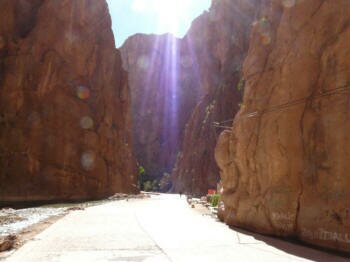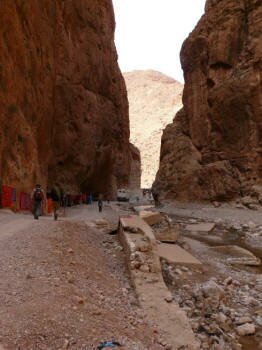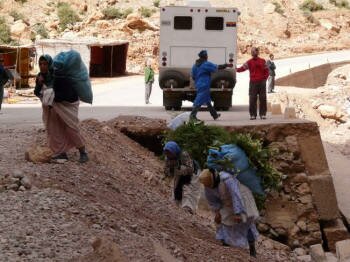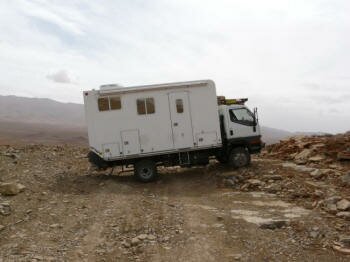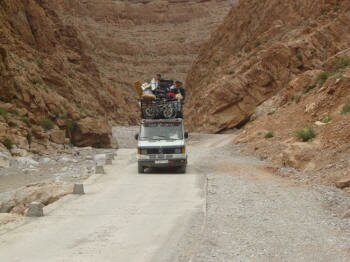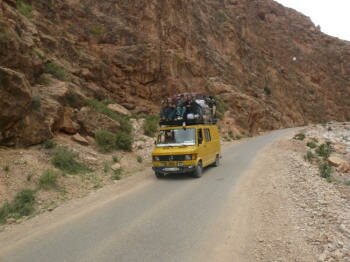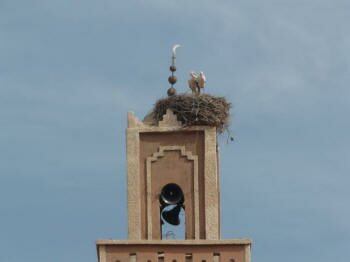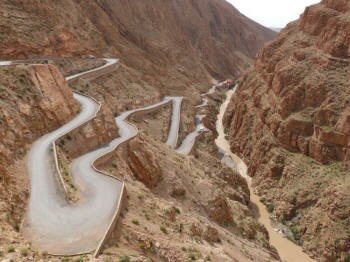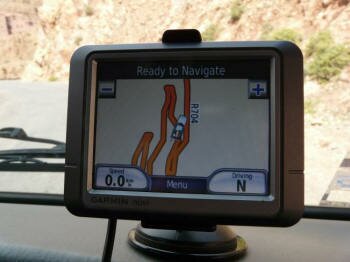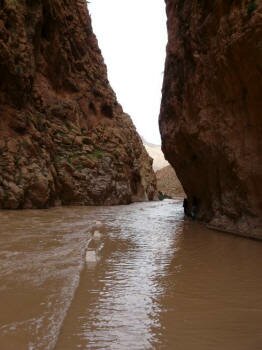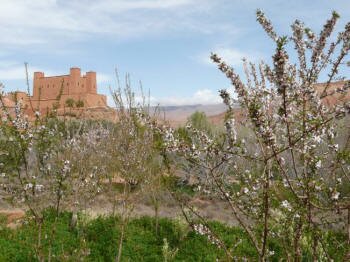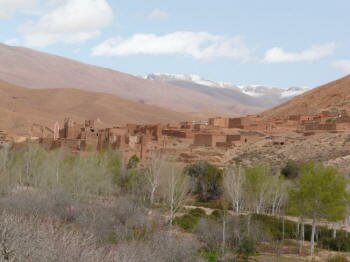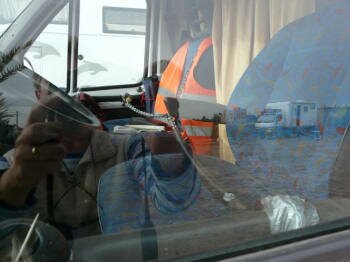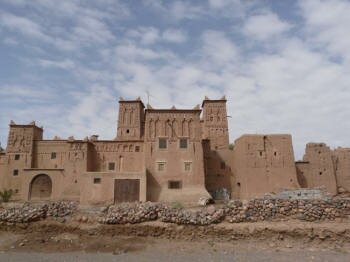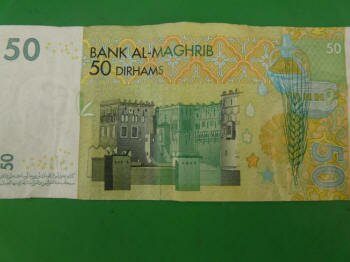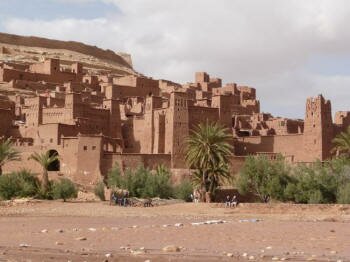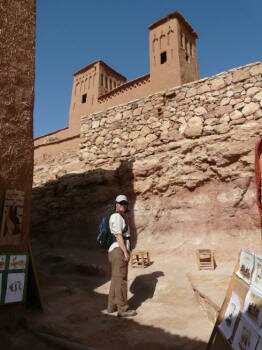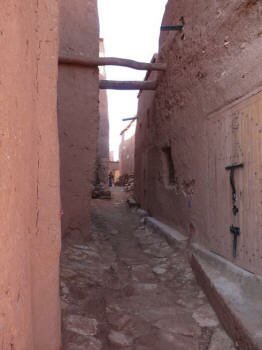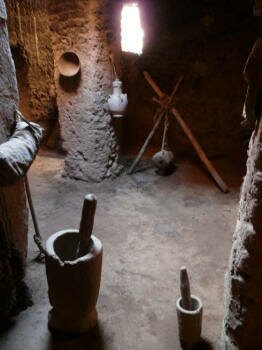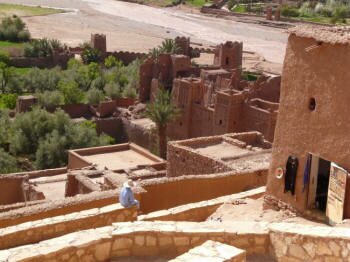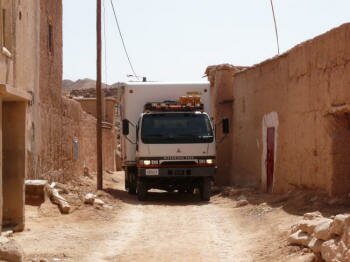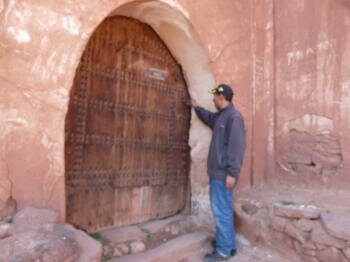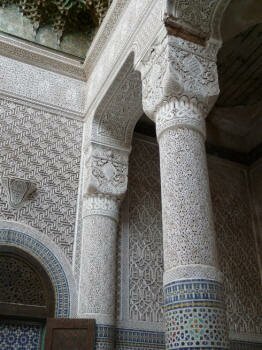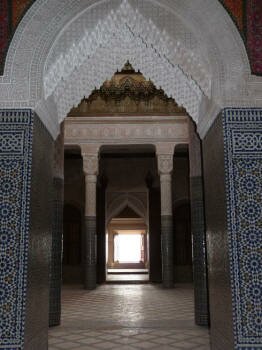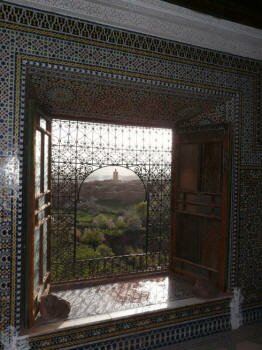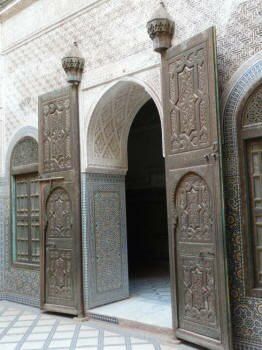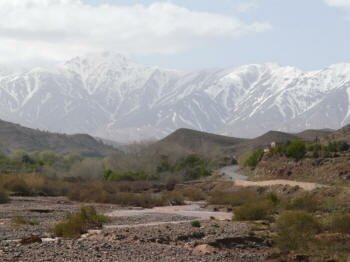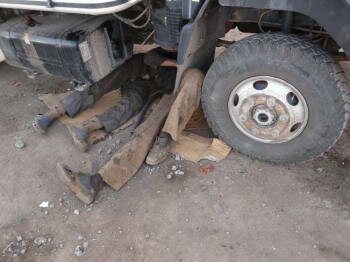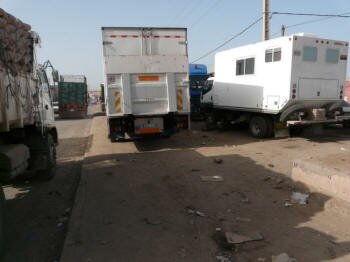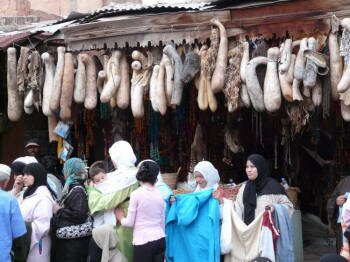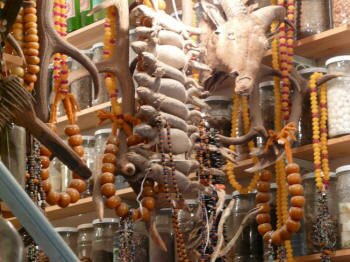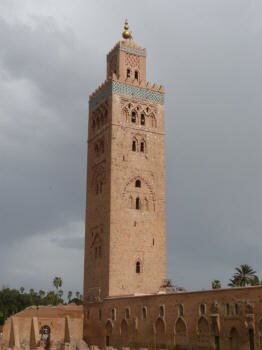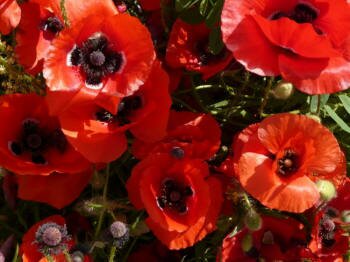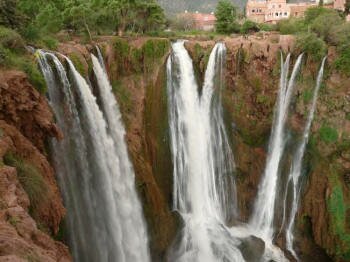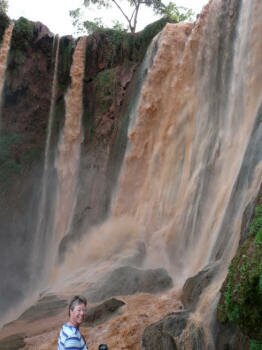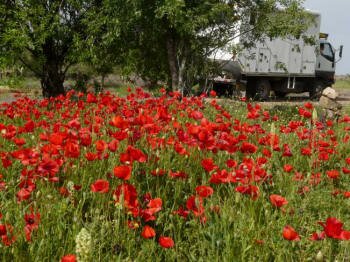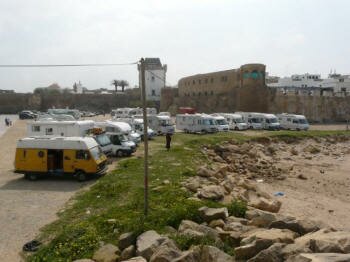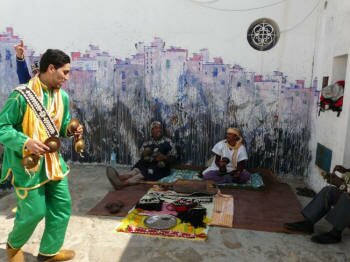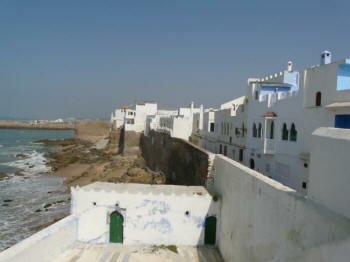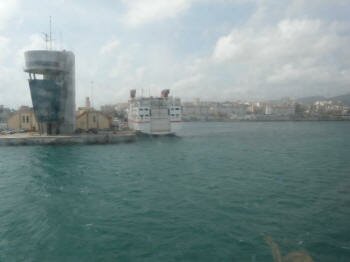March 6, 2009
|
We did a morning coffee walk (walk with our cups of coffee - a very American thing we've been told) back up into the dunes for a final walk before leaving the dunes behind us. The morning sun was just incredible as it cast shadows across the dunes highlighting just about every ripple on the sand.
|
After breaking camp we drove along the back roads outside of Rissani, through the palmeries and past so many kasbahs and ksars that we couldn't keep count - many of them were ruined but some were still inhabited. One of the more interesting "abandoned kashbahs was the one that housed the last governor of this region. Only a handful of families still make their homes here - giving this a very abandoned feel. But as we wandered the alleys and peered into the courtyards, we were surprised to find many of the walls still adorned with the original stucco designs. Although impressed that the designs, paintings and tile work still remained, we could only sigh knowing that in a few short years these would like be washed away by neglect and failure of anyone to preserve this wonderful history.
We spent so much time exploring that we drove until nearly dark and camped at a campground on the highway just short of the Todra Gorge.
March 7 - 8, 2009
After consulting a hand-drawn map at the campground, we decided to drive an indicated scenic route through more palmeries. The drive was interesting with some very nice views of snow capped mountains (!) but it was when we found an abandoned ksar, that the drive became really worthwhile. We were invited to look around by a local and spent about a half hour wandering through the ruins and speculating about life there.
We finally arrived at the bottom of Todra Gorge just before lunch time. We stopped at a nice campground, chose a spot and had lunch. We then headed up the gorge. Most of the gorge is highly populated, but where it starts to narrow down, it becomes uninhabited, except for all the tourist touts and parked buses. Despite this, the gorge is beautiful and entrancing, especially if you travel beyond the main tourist area (where the buses all stop.) We spent a couple of hours walking around and taking pictures and then returned to the campground. The roadway through the gorge had been washed out several years ago by a terrible winter storm, but the route was easy to follow and we felt compelled to drive through the gorge.
When we returned, we were surprised to see it had filled up and we were glad we had reserved a nice spot before setting out. The other campers were very friendly and we spent a fun evening with a couple of bicycle riders from Holland and a couple in a camper from Great Britain.
March 9, 2009
| Today we attempted to follow a piste over the mountains between the Todra and Dades Gorges but the road deteriorated to a badly maintained two track that was impassable for us. We were forced to make what amounted to a six point turn on a very narrow track at the last point wide enough for us to attempt a turn around. The scenery was stark but beautiful and it was a great drive, but we had to retrace our steps down the mountain and back through the Todra Gorge to the highway at Tinerhir. On the drive down out of the mountains we passed many vans and trucks filled ridiculous past their limits with people, animals and merchandise returning from Tinerhir and market day. Since we were back in a town, we took the opportunity to do some grocery shopping and then drove to a campground overlooking the beginning of the Dades Gorge where once again we were one of the last to get a space. |
March 10, 2009
| Today we took a great drive through the Dades Gorge, past dozens of villages each with their own ruined kasbah or ksar. On many of the Mosque Minarets storks had built nests and were rearing their young. it is thought to be good luck to have a stork nest on your building - but boy did they make a mess. Some of the kasbahs we have been seeing lately were built by the ruling Glaoui clan during the late 19th and early 20th centuries and are quite beautiful. |
| We drove up an incredible series of switchbacks eventually reaching the main part of the Dades Gorge, which was flooded due to snow melt and rain runoff from the storms of the last few days. Lucky for us that we couldn't take the piste over the mountains last night as we might have gotten stuck in the mountains by snow or flash floods! It was hard to compare the two gorges against each other, they were both different and yet they both had qualities that set them apart from each other. We were glad that we had the opportunity to drive through them both. |
| We headed back out of the gorge to the highway and down to the Skoura oasis. Along the way we met up again with our bicycling friends again. Unfortunately it was another rainy night. Walking around camp that evening, we spied one of the overland vehicles that was secured by the most frightening security that we had spotted yet. They had the doors of their vehicle chained, from the inside. We couldn't imagine how afraid these travelers must be - and how unnecessary their precautions really were (from our experience). |
March 11, 2009
This morning we walked over to the Amrhidil Kasbah that is featured on the 50dirham note. The kasbah was in view from our campsite and was impressive even from there. The family that owns it still lives there occasionally so it is in pretty nice shape. We wandered around for a while and then drove back through Ouarzazate where we stayed two weeks ago. This time we stayed only long enough to do a bit of grocery shopping, eat a lunch out and take care of some internet work.
We reached our camp at Ait Benhaddou in mid afternoon. Ait Benhaddou is an old town with a fabulous ksar built on a hillside overlooking the river. The ksar has been pretty much rebuilt, due to its popular use in films which include Lawrence of Arabia, Sodam and Gomorrah and Jesus of Nazareth. Some of the rebuilding has been through the auspices of UNESCO and the government recently announced plans to "rehabilitate" the ksar.
|
The ksar is across what is usually a dry wash from the main part of the town. But because of all the recent rain, the water was running too high to easily across so we decided to wait until morning and return with our rubber boots.
|
March 12, 2009
This morning we crossed the river wearing our wellies (rubber boots), making it across dry, but water overflowed into our boots on the way back. Not too bad other than wet socks and dripping boots, luckily we brought walking shoes just in case. Our time spent exploring the town was fun and reminded us of our time exploring a similar village, Patzcuaro in Mexico. There were many narrow alleyways, steep staircases climbing the hills, and many of the homes still has original furnishings on display.
| In the afternoon we attempted another piste over the mountains (I know, this story is getting old) but again we were turned back, this time due to rock falls that created an overhang of rock that was too low for our Fuso to pass under. Again the drive was great, fording the river and passing through villages where we barely fit between the buildings lining the piste. We retraced our path again, down to the highway, then continued up the Tizi n'Tichka pass along mountains covered in snow, and then detouring to the main Glaoui kasbah at Telouet. |
We had to search around the village for the guardian of the kasbah who had the huge skeleton style key for the front door and who gave us a great tour of the few buildings still standing. Sad to think that this kasbah has deteriorated so badly in just the last fifty years since it was abandoned - what will it be like in another 10, or 50. The rooms still intact were decorated with magnificent stucco designs reminiscent of the designs we saw in the Alhambra in Granada, Spain. By the time we were done it was late in the day and getting dark. We headed back to a bush camp that we had seen on the road in, but there was a car broken down on the side of the road with three guys in it. We would have been in full view, so we headed on. We finally found a spot, not very far off the road but in the trees and it was already dark. It is getting more difficult to find open spaces as there are people and villages seemingly everywhere.
March 13 - 17, 2009
| Today we drove the Tizi n'Tichka pass across the Atlas mountains into Marrakesh. This was a windy road over the top at 2,260m (7,458ft) with fabulous views of snow capped mountains. It took us several hours to negotiate the 68 miles, finally arriving late morning. Knowing what our priorities were, we made a beeline for the Marjane supermarket. This was the first really large supermarket we had seen since Ghana. We had been always been able to pick up the essentials, but we rarely had been able to find those extra items that make life more interesting. We ended up spending 3 hours (1-1/2 before lunch and 1-1/2 after lunch) and $175.00us before we were done. |
Finally lugging our bloated refrigerator off to the campground, we arrived late afternoon and settled in.
The next morning we had to leave early for an appointment with a mechanic for some maintenance. Before we left however, we reserved a campsite where we would have electricity available and set off. Our appointment turned out to be interesting in that in involved a trip across town with the mechanic in the front and Kim in the back to find "just the right people" to replace our bushings. Well, we don't really understand this as we had our bushings replaced by a little old mechanic on the side of the road in Peru, but whatever. We then had to return to our original mechanic to have them do our alignment and oil change. The extra trip didn't cost us anything extra, so alls well.
We returned to the campground and proceeded to spend the next 2 days alternating between lazing around, socializing and actually doing chores, like laundry and cleaning the truck.
On our fifth day in Marrakesh, we moved from the campground to a camper parking area in the center of town, across from the Djemaa el Fna square where Marrakesh's famous night market is held. We spent the afternoon in the souks shopping and wandering poking our heads into all the fascinating shops - ceramics, metal, the herbalist and the "women's" market. The women's is where the women come to buy and sell used clothing. We found it ironic that all of these women who are covered head to foot in their chadors that the market is held in the old slave market.
| After sunset we headed back to the square where we wandered around the market looking for tonight's dinner. We had snails for an appetizer and then had a typical meal consisting of fish, eggplant, skewers of meat, olives and bread. It was wonderful. We then wandered back to the truck through the throngs of people and entertainers. Just outside the parking lot we found that the speakers on the mosque were pointed straight at us, so we would be well aware of each call to prayer "shouted" from the rooftop. |
March 18, 2009
| With a sad goodbye, we left Marrakesh behind. We took a back road drive through the foothills to the Cascades de Ouzoud. This is a beautiful time of year - spring with wildflowers and bright red poppies covering the hillsides. |
We reached the Cascades amongst a darkening sky accompanied with the sound of distant thunder. We grabbed our rain gear and took a quick hike to the top of the falls - a great view of the falls dropping off of the plateau in a horseshoe of ribbons of water. BANG, lightning and thunder, then rain - lots of rain. We made our way back to the campsite, only to find the police going from camper to camper issuing flash flood warnings and telling us to abandon our sites and move to higher ground! We were one of the lasts to move, so we ended up parked on the road, not very flat. But we had a nice view of all the goings on and if the river flooded, well we'd have a great view of that too!
March 19, 2009
| Luckily there was no flood last night, but the water did get much higher and the color of the falls changed from nearly clear to nearly mud due to the large amount of rain that fell. Since we had to move onto the road, we got up much earlier than normal and started our day at sunrise. We hiked to the falls to see their muddy cascades, ate some homemade crepes bought from one of the village women, then headed out of the Atlas Mountains for the last time. We expected a boring drive across the "phosphate plains" with views broken only by mine tailings, but were surprised to find ourselves driving through rolling hills and farm land with even more wildflowers blooming. We made a small vase from the bottom of a plastic water bottle, filled it with cut wildflowers and stuck it in our cup holder! It turned into a longer day of travel than expected due to the lack of bush camping spots, but we finally found a quiet spot at the back of a restaurant/service station in Tiflet, just half an hour from Rabat (where we had to get some of our visas for West Africa last November!) |
March 20, 2009
Arriving back at the Atlantic coast, we hit the Marjane in Kenitra (just 'cause we could) and had lunch at the Lac de Sidi-Boughaba where we saw a couple of new ducks that weren't in our bird book and a couple of raptors - a hawk and a kite. We had hoped to spend the day at the beach at Mehdiya Plage but when we got there the place was really dumpy with lots of trash so we moved on to the Aire at Larache which is a cheap camping site also being used by tons of European campervans.
March 21, 2009
We arrived at the free camp in the car park at the foot of the old city walls at Asilah just before lunch. This is a great location, on the beach, next to the marina and within easy walking distance of the old walled town. We had a nice lunch at a restaurant with outside tables at the base of the city walls and it just so happened that it was also right under the minaret of the main mosque so we were perfectly situated to hear the mid-day call to prayer. We spent the afternoon relaxing and watching people watching us.
March 22, 2009
We drove across the northwestern tip of the country today, from the Atlantic Coastline to the Mediterranean. Unfortunately we also went from beautiful blue skies into some rain and overcast but, whatcha gonna do? We did our final grocery shopping in Morocco (where everything is cheaper) and camped in the beach town of Martil.
March 23, 2009
Today was our departure day from Morocco and the last day of the Morocco and West Africa Expedition. As it so happened, it also turned out to be our first and only run in with the Moroccan Police. This happened on our way to the border at Ceuta where we would catch the ferry back to Algeciras in Spain. Don was preoccupied with finding one last fuel station so that we could top up our fuel tank and use up our remaining Dirhams that when he found a station (they all seem to be on the wrong side of the road for us) and had to circle around back, he drew the wrath of a taxi (loud horn honking) by failing to yield, which in turn drew the attention of a police office who just happened to be waiting right there. Lucky for Don, this particular officer didn't speak any English and just waved us away. Whew!
| Then it was up the road a few final kilometers to the border, a quick crossing out of Morocco into Ceuta where we were able to exchange our last Dirhams for Euros, and then on to the port. At the ferry terminal, we showed our open-end return ticket and were directed into a line for the next ferry. In less than an hour the ferry loaded us up and sailed across the Mediterranean to deposit us on European soil. This last six weeks in Morocco were a wonderful finale to the expedition. Thanks for joining us, see you on the next Adventure Learning Foundation Expedition. |
